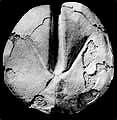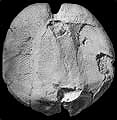The Echinoid Directory
Kina Henderson, 1975, p. 28
| Diagnostic Features |
|
|---|---|
| Distribution | Upper Eocene to Upper Oligocene, New Zealand. |
| Name gender | feminine |
| Type | Kina gracilis Henderson, 1975, p. 28, by original designation. |
| Species Included | Only the type species. |
| Classification and/or Status |
|
| Remarks |
|


